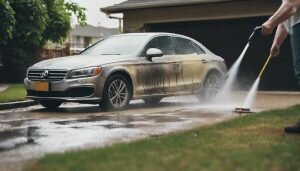To detail your car before selling it, follow these steps:
Gather Your Supplies
- Car wash soap
- Wax and polish
- Glass cleaner
- Interior cleaner
- Microfiber towels, sponges, brushes, vacuum cleaner
Exterior Cleaning
- Wash: Use car wash soap and a soft sponge; rinse first to remove loose dirt.
- Polish: Perform paint correction with a polishing compound.
- Tires: Clean tires and apply a tire shining product.
Interior Detailing
- Vacuum thoroughly
- Shampoo Upholstery: Use high-quality cleaner.
- Dashboard: Condition with a non-abrasive cleaner.
- Windows: Clean with a glass cleaner.
Final Touches
- Inspect and polish headlights, apply high-quality wax, and make sure the interior matches the pristine exterior. Discover advanced tips to impress potential buyers.
Gather Your Supplies

Before you start detailing your car, make sure you've gathered all the necessary supplies to get the job done right. Proper product selection and tool maintenance are vital in achieving the best results.
Product Selection
First, choose high-quality products designed for automotive care. You'll need:
- Car wash soap
- Wax and polish
- Glass cleaner
- Interior cleaner
Avoid using household cleaners, as they can damage your car's surfaces. Look for products specifically formulated for automotive use to guarantee they are safe and effective.
Tool Maintenance
Next, focus on tool maintenance. Clean, well-maintained tools make the detailing process more efficient and prevent damage. Gather these essential tools:
- Microfiber towels
- Sponges
- Brushes
- Vacuum cleaner
Before starting, inspect your tools. Make certain that your microfiber towels are clean and free of debris, as dirt particles can scratch surfaces. Replace worn-out sponges and brushes to avoid ineffective cleaning or scratching. Check your vacuum for sufficient suction and a clean filter to maximize performance.
Exterior Cleaning
Exterior Cleaning
To achieve a showroom shine, start by thoroughly washing the car's exterior using a high-quality car wash soap and soft sponge. Make sure to rinse the car with water first to remove any loose dirt or debris. Then, apply the soap and gently scrub the surface, paying close attention to areas that accumulate grime, such as the lower panels and wheel wells.
Paint Correction
After washing, inspect the car for any scratches or swirl marks. If you find any, perform paint correction using a polishing compound and a microfiber cloth. This process helps to remove surface imperfections and restore the car's original luster. Work in small sections, applying the compound in a circular motion until the scratches are no longer visible.
Tire Shining
Next, focus on the tires. Clean them thoroughly with a tire cleaner to remove any dirt or brake dust. Once clean, apply a tire shining product to give them a glossy finish. This step not only enhances the overall appearance of the car but also signals to potential buyers that the vehicle has been well-maintained.
Interior Detailing

Interior Detailing
Start by thoroughly vacuuming the interior to remove any dirt, dust, and debris from the seats, carpets, and floor mats. Pay special attention to the crevices and under the seats, where crumbs and dirt often accumulate.
Upholstery Shampooing
Next, focus on upholstery shampooing. Use a high-quality upholstery cleaner to treat stains and refresh the fabric. Apply the shampoo to the seats and carpets, scrubbing gently with a brush. Let the shampoo sit for a few minutes, then use a wet-dry vacuum to remove the cleaner and any loosened dirt. This process will leave your car's interior looking and smelling fresh.
Dashboard Conditioning
Now, move on to the dashboard. Clean it with a mild, non-abrasive cleaner to remove dust and grime. Once clean, apply a dashboard conditioning product to restore its shine and protect it from UV damage. Use a microfiber cloth to apply the conditioner evenly, ensuring a smooth finish.
Additional Touches
Don't forget the windows and mirrors. Use a glass cleaner to wipe them down, ensuring no streaks are left behind. Finally, check and clean smaller areas such as cup holders, door panels, and air vents. Attention to these details will make your car's interior look pristine and inviting to potential buyers.
Engine Bay Cleaning
Cleaning the engine bay not only enhances your car's aesthetic appeal but also demonstrates to potential buyers that it's been well-maintained. A clean engine bay can greatly boost a buyer's confidence in your vehicle's overall condition.
Steps to Clean the Engine Bay
- Protecting Components: Before starting, cover sensitive components like the battery, alternator, and exposed wiring with plastic bags. This prevents water damage and guarantees these parts remain functional.
- Degreaser Use: Apply a quality degreaser to break down built-up grease and grime. Spray the degreaser evenly over the engine bay, focusing on particularly dirty areas. Let it sit for a few minutes to allow the chemicals to penetrate and loosen the dirt.
- Scrubbing and Rinsing: Use a soft brush to scrub away the loosened grime. Be thorough but gentle to avoid damaging any components. After scrubbing, rinse the engine bay with a low-pressure hose, making sure you don't force water into delicate parts.
- Drying: After rinsing, use a clean microfiber cloth to dry the engine bay. An air compressor can help speed up the drying process, especially in hard-to-reach areas.
Final Touches

Final Touches
After cleaning the engine bay, you'll want to add the finishing touches to make certain your car looks its absolute best for potential buyers. These final steps will enhance the car's appearance and can make a significant difference in selling it quickly and at a good price.
Polishing Headlights
- Inspect Headlights: Check for any cloudiness or yellowing. This can age your car's look.
- Use a Headlight Restoration Kit: These kits usually come with everything you need. Follow the instructions carefully.
- Polish: After sanding, apply the polish included in the kit. This will make your headlights shine like new.
Applying Wax
- Choose the Right Wax: Make sure to select a high-quality car wax. Synthetic waxes usually last longer.
- Apply Evenly: Use a foam applicator pad to spread the wax evenly over the car's surface.
- Buff to Shine: After the wax has dried, use a clean microfiber cloth to buff the surface until it shines.
Final Inspection
- Check for Missed Spots: Walk around the car and make sure no areas are overlooked.
- Interior Check: Make sure the inside is just as pristine as the outside.





